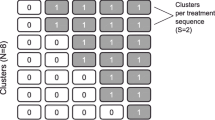Abstract
This paper studies model-based and design-based approaches for the analysis of data arising from a stepped wedge randomized design. Specifically, for different scenarios we compare robustness, efficiency, Type I error rate under the null hypothesis, and power under the alternative hypothesis for the leading analytical options including generalized estimating equations (GEE) and linear mixed model (LMM)-based approaches. We find that GEE models with exchangeable correlation structures are more efficient than GEE models with independent correlation structures under all scenarios considered. The model-based GEE Type I error rate can be inflated when applied with a small number of clusters, but this problem can be solved using a design-based approach. As expected, correct model specification is more important for LMM (compared to GEE) since the model is assumed correct when standard errors are calculated. However, in contrast to the model-based results, the design-based Type I error rates for LMM models under scenarios with a random treatment effect show Type I error inflation even though the fitted models perfectly match the corresponding data-generating scenarios. Therefore, greater robustness can be realized by combining GEE and permutation testing strategies.

Similar content being viewed by others
Change history
17 August 2020
The original version of this article unfortunately contained an error in ‘R code’ under Appendix section.
References
Brown CA, Lilford RJ (2006) The stepped wedge trial design: a systematic review. BMC Med Res Methodol 6:54
Diggle P, Heagerty P, Liang K, Zeger S (2002) Analysis of longitudinal data, 2nd edn. Oxford University Press, Oxford
Golden MR, Kerani RP, Stenger M, Hughes JP, Aubin M, Malinski C, Holmes KK (2015) Uptake and population-level impact of expedited partner therapy (EPT) on Chlamydia trachomatis and Neisseria gonorrhoeae: the Washington State Community-level Randomized Trial of EPT. PLoS Med 12(1):e1001777
Good P (2005) Permutation, parametric and bootstrap tests of hypotheses, 3rd edn. Springer, New York
Hooper R, Teerenstra S, de Hoop E, Eldridge S (2016) Sample size calculation for stepped wedge and other longitudinal cluster randomized trials. Stat Med 35:4718–4728
Hussey MA, Hughes JP (2007) Design and analysis of stepped wedge cluster randomized trials. Contemp Clin Trials 28:182–191
Hughes JP, Granston TS, Heagerty PJ (2015) Current issues in the design and analysis of stepped wedge trials. Contemp Clin Trials 45:55–60
Hughes JP, Heagerty PJ, Xia F, Ren Y (2019) Robust inference in the stepped wedge design. Biometrics. https://doi.org/10.1111/biom.13106
Ji X, Fink G, Robyn PJ, Small DS (2017) Randomization inference for stepped-wedge cluster-randomized trials: an application to community-based health insurance. Ann Appl Stat 11:1–20
Killiam WP, Tambatamba BC, Chintu N, Rouose D, Stringer E, Bweupe M, Yu Y, Stringer JSA (2010) Antiretroviral therapy in antenatal care to increase treatment initiation in HIV-infected pregnant women: a stepped-wedge evaluation. AIDS 24:85–91
Leyrat C, Morgan EK, Leurent B, Kahan CB (2018) Cluster randomized trials with a small number of clusters: which analyses should be used? Int J Epidemiol 47:321–331
Li P, Redden DT (2015) Comparing denominator degrees of freedom approximations for the generalized linear mixed model in analyzing binary outcome in small sample cluster-randomized trials. BMC Med Res Methodol 15:38
Mdege ND, Man MS, Taylor CA, Torgerson DJ (2011) Systematic review of stepped wedge cluster randomized trials shows that design is particularly used to evaluate interventions during routine implementation. J Clin Epidemiol 64:936–948
Rhoda DA, Murray DM, Andridge RR, Pennell ML, Hade EM (2011) Studies with staggered starts: multiple baseline designs and group-randomized trials. Am J Publ Health 101:2164–2169
Sharples K, Breslow N (1992) Regression analysis of correlated binary data: some small sample results for the estimating equation approach. J Stat Comput Simul 42:1–20
Taljaard M, Teerenstra S, Ivers NM, Fergusson DA (2016) Substantial risks associated with few clusters in cluster randomized and stepped wedge designs. Clin Trials 13:459–463
Thompson JA, Davey C, Fielding K, Hargreaves JR, Hayes RJ (2018) Robust analysis of stepped wedge trials using cluster-level summaries within periods. Stat Med 37:2487–2500
Westgate PM (2013) On small-sample inference in group randomized trials with binary outcomes and cluster-level covariates. Biom J 5:789–806
Woertman W, de Hoop E, Moerbeek M, Zuidema SU, Gerritsen DL, Teerenstra S (2013) Stepped wedge designs could reduce the required sample size in cluster randomized trials. J Clin Epidemiol 66:752–758
Funding
This research was supported by the National Institute of Allergy and Infectious Diseases Grant AI29168 and PCORI contract ME-1507-31750.
Author information
Authors and Affiliations
Corresponding author
Appendix: R, Stata, and SAS code
Appendix: R, Stata, and SAS code
Here we present basic R, Stata, and SAS code for fitting common models for stepped wedge designs with cross-sectional data collection at each time point. See [5,6,7].
-
I
Linear mixed models
-
(1)
\( {\text{Random cluster effect}}:Y_{ijt} = \mu + a_{i} + \beta_{t} + X_{it} \theta + e_{ijt} \)
-
(2)
\( {\text{Random cluster and cluster}} \times {\text{time effect}}:Y_{ijt} = \mu + a_{i} + \beta_{t} + b_{it} + X_{it} \theta + e_{ijt} \)
-
(3)
\( {\text{Random cluster}},{\text{ cluster}} \times {\text{time and treatment effect }}({\text{corr}}(a_{i} ,_{{}} c_{i} ) = 0):Y_{ijt} = \mu + a_{i} + \beta_{t} + b_{it} + X_{it} (\theta + c_{i} ) + e_{ijt} \)
-
(4)
\( {\text{Random cluster, cluster}} \times {\text{time and treatment effect }}({\text{corr}}(a_{i} ,_{{}} c_{i} ) = \rho ):Y_{ijt} = \mu + a_{i} + \beta_{t} + b_{it} + X_{it} (\theta + c_{i} ) + e_{ijt}, \)
where
ai ~ N(0, τ2)
bit ~ N(0, γ2)
ci ~ N(0, ν2)
eijt ~ N(0, σ2).

-
(1)
-
II
Generalized estimating equation models
-
(5)
Independent working correlation
-
(6)
Exchangeable working correlation

-
(5)
Rights and permissions
About this article
Cite this article
Ren, Y., Hughes, J.P. & Heagerty, P.J. A Simulation Study of Statistical Approaches to Data Analysis in the Stepped Wedge Design. Stat Biosci 12, 399–415 (2020). https://doi.org/10.1007/s12561-019-09259-x
Received:
Revised:
Accepted:
Published:
Issue Date:
DOI: https://doi.org/10.1007/s12561-019-09259-x






